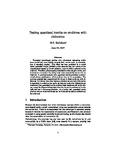Testing quantised inertia on emdrives with dielectrics
| dc.contributor.author | McCulloch, ME | |
| dc.date.accessioned | 2018-03-05T12:37:59Z | |
| dc.date.available | 2018-03-05T12:37:59Z | |
| dc.date.issued | 2017-05-01 | |
| dc.identifier.issn | 0295-5075 | |
| dc.identifier.issn | 1286-4854 | |
| dc.identifier.other | ARTN 34003 | |
| dc.identifier.uri | http://hdl.handle.net/10026.1/10929 | |
| dc.description.abstract |
Truncated-cone-shaped cavities with microwaves resonating within them (emdrives) move slightly towards their narrow ends, in contradiction to standard physics. This effect has been predicted by a model called quantised inertia (MiHsC) which assumes that the inertia of the microwaves is caused by Unruh radiation, more of which is allowed at the wide end. Therefore, photons going towards the wide end gain inertia, and to conserve momentum the cavity must move towards its narrow end, as observed. A previous analysis with quantised inertia predicted a controversial photon acceleration, which is shown here to be unnecessary. The previous analysis also mispredicted the thrust in those emdrives with dielectrics. It is shown here that having a dielectric at one end of the cavity is equivalent to widening the cavity at that end, and when dielectrics are considered, then quantised inertia predicts these results as well as the others, except for Shawyer's first test where the thrust is predicted to be the right size but in the wrong direction. As a further test, quantised inertia predicts that an emdrive's thrust can be enhanced by using a dielectric at the wide end. | |
| dc.format.extent | 34003-34003 | |
| dc.language.iso | en | |
| dc.publisher | IOP Publishing | |
| dc.title | Testing quantised inertia on emdrives with dielectrics | |
| dc.type | journal-article | |
| dc.type | Journal Article | |
| plymouth.author-url | https://www.webofscience.com/api/gateway?GWVersion=2&SrcApp=PARTNER_APP&SrcAuth=LinksAMR&KeyUT=WOS:000407226300012&DestLinkType=FullRecord&DestApp=ALL_WOS&UsrCustomerID=11bb513d99f797142bcfeffcc58ea008 | |
| plymouth.issue | 3 | |
| plymouth.volume | 118 | |
| plymouth.publication-status | Published | |
| plymouth.journal | EPL (Europhysics Letters) | |
| dc.identifier.doi | 10.1209/0295-5075/118/34003 | |
| plymouth.organisational-group | /Plymouth | |
| plymouth.organisational-group | /Plymouth/Faculty of Science and Engineering | |
| plymouth.organisational-group | /Plymouth/Faculty of Science and Engineering/School of Biological and Marine Sciences | |
| plymouth.organisational-group | /Plymouth/REF 2021 Researchers by UoA | |
| plymouth.organisational-group | /Plymouth/REF 2021 Researchers by UoA/UoA12 Engineering | |
| plymouth.organisational-group | /Plymouth/Users by role | |
| plymouth.organisational-group | /Plymouth/Users by role/Academics | |
| dc.identifier.eissn | 1286-4854 | |
| dc.rights.embargoperiod | Not known | |
| rioxxterms.versionofrecord | 10.1209/0295-5075/118/34003 | |
| rioxxterms.licenseref.uri | http://www.rioxx.net/licenses/all-rights-reserved | |
| rioxxterms.type | Journal Article/Review |


